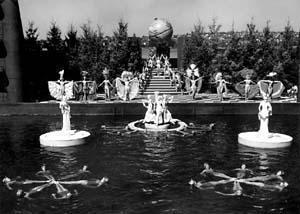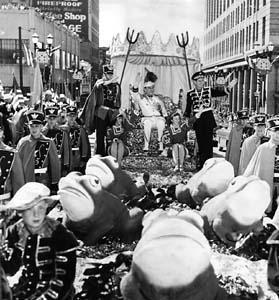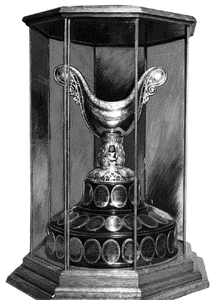By Sharon Boswell
and Lorraine McConaghy
Special to The Times

Slo-mo-shun IV launched Seattle and Seafair into the world of unlimited hydroplane racing.
Stan Sayres and his team developed and built the 1,800-horsepower thunderboat locally,
testing it on Lake Washington. Between 1950 and 1954, Slo-mo IV and its sister boat, Slo-mo V,
captured an unprecedented five consecutive Gold Cup trophies.
Photo Credit: Seattle Times.

Seafair was the brainchild of Greater Seattle Inc., a group of prominent local
boosters hoping to use Seattle's 100th anniversary as a springboard to increased civic cooperation
and promotion. Modeled after successful events like the New Orleans Mardi Gras and St. Paul's Winter Carnival,
Seafair began as an attempt to build a nationwide reputation on the city's maritime heritage.
Seattle had staged similar extravaganzas as early as the
1909 Alaska-Yukon-Pacific Exposition. That fair attracted more than 3.7 million visitors
during its 4 1/2-month run, and its success encouraged city fathers, then facing a serious business
slump, to organize a yearly celebration advertising the region's advantages.
Their first attempt resulted in Potlatch, a weeklong festival featuring dozens of parades,
concerts and special events, including a visit by battleships from the Pacific fleet. Born in 1911,
the event borrowed loosely from the region's Indian heritage for its unifying theme.
The onset of World War I brought these first Potlatch celebrations to an end after
only three years, and not until 1934 did Depression-weary Seattleites
revive the tradition. The Junior Chamber of Commerce joined other business groups in staging a
scaled-down version of Potlatch with a focus on friendly neighborhood atmosphere rather than lavish spectacle.
A few Indian themes remained, while Paul Bunyan folklore and community-sponsored royalty were added for a dash
of pomp and history.
But international conflict once again intervened, and in 1942
Potlatch was suspended for the duration. Civic leaders vowed that "a bigger and better celebration"
would follow World War II, but except for a 1948 Fly-in Potlatch --
honoring the local aviation industry -- the event never revived.
 Seafair's grand parade featured lavish floats and a whole cast of royalty led by King Neptune,
who in 1952 was portrayed by civic leader E.L. Blaine Jr.
Photo Credit: Seattle Times.
Seafair's grand parade featured lavish floats and a whole cast of royalty led by King Neptune,
who in 1952 was portrayed by civic leader E.L. Blaine Jr.
Photo Credit: Seattle Times.
AS MEMBERS OF GREATER SEATTLE TESTED THE WATERS WITH A NEW CIVIC FESTIVAL
IN 1950,
Seafair surfaced around a more generic nautical theme. King Neptune -- portrayed by a prominent civic leader --
presided over the event, while local beauties vied for the title of Queen of the Seas.
Other Seafair boosters, costumed as Davy Jones and his pirate band, caused spirited mayhem, playing
tricks on those who did not join the merrymaking or buy special Seafair pins.
The national water-skiing championships, never before held in the West, became part of this
first Seafair, as did numerous other sporting events, but the Aqua Follies proved to be the greatest crowd pleaser.
This "swimmusical review," held in the specially built Aqua Theater on Green Lake's south end, featured a cast
of more than 100 lavishly outfitted singers, dancers, swimmers and divers performing in the water or on a floating
stage.
On the final day of the celebration, three old stern-wheelers, including the W.T. Preston,
raced on Elliott Bay. The burning of the historic steamship Bellingham by the Seafair pirates provided a spectacular
climax to four successful days of revelry.
Throughout the prosperous 1950s, the era's bigger-is-better mentality shaped Seafair,
which stretched to 10 days in length as sponsors added more family activities and more pageantry.
A prime minister, an honor guard and dozens of white-suited commodores joined King Neptune and his queen;
a whole court of junior royalty mimicked the adults. Seafair clowns competed with pirates in crazy antics;
eight different parades, including one by torchlight, snaked through city streets; 15,000 sailors participated
in an expanded Fleet Week observance.
 The cup, at left, was hydro racing's most coveted prize.
The cup, at left, was hydro racing's most coveted prize.
Photo Credit: Seattle Times.
HYDROPLANE RACING, AN INNOVATION OF THE 1951 SEAFAIR, quickly became the celebration's signature event.
The preceding year, Seattleite Stan Sayres had set a world speedboat record at 160.3 mph in the
locally designed and built Slo-mo-shun IV, going on to win the sport's prestigious Gold Cup race
in Detroit. Sayres' victory brought the next race to Lake Washington, coinciding with Seafair.
By 1954, when the Slo-mos had won an unprecedented fifth straight Gold Cup, the city was filled with
"hydromaniacs" as nearly 500,000 turned out to watch the great thunderboats compete.
Civic pride helped keep the hydros racing in Seattle. Local residents contributed money --
often in $1 or $2 increments -- to help Sayres defray the huge cost of testing his boats.
And in years when the Gold Cup left Seattle, a Seafair Trophy Race still provided competition.
Seafair thrived in the wake of the hydroplanes, surviving because the community supported its
commitment to Seattle and to family fun.
Historians Sharon Boswell and Lorraine McConaghy teach at local universities and do research,
writing and oral history. Original newspaper graphics courtesy of the Seattle Public Library.